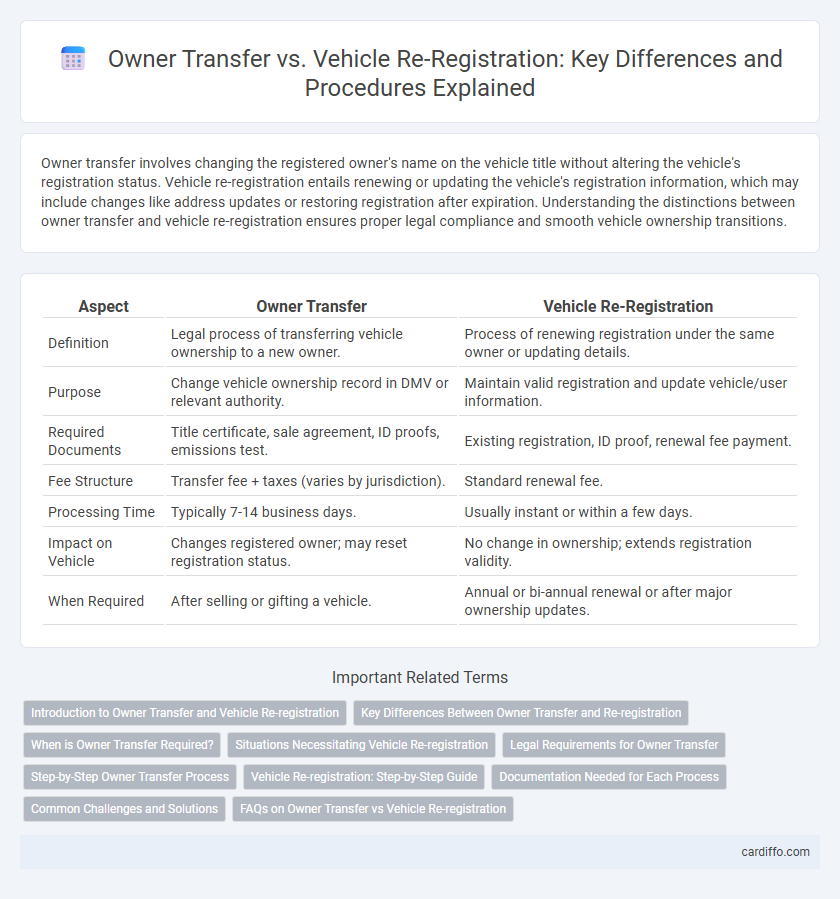Owner transfer involves changing the registered owner's name on the vehicle title without altering the vehicle's registration status. Vehicle re-registration entails renewing or updating the vehicle's registration information, which may include changes like address updates or restoring registration after expiration. Understanding the distinctions between owner transfer and vehicle re-registration ensures proper legal compliance and smooth vehicle ownership transitions.
Table of Comparison
| Aspect | Owner Transfer | Vehicle Re-Registration |
|---|---|---|
| Definition | Legal process of transferring vehicle ownership to a new owner. | Process of renewing registration under the same owner or updating details. |
| Purpose | Change vehicle ownership record in DMV or relevant authority. | Maintain valid registration and update vehicle/user information. |
| Required Documents | Title certificate, sale agreement, ID proofs, emissions test. | Existing registration, ID proof, renewal fee payment. |
| Fee Structure | Transfer fee + taxes (varies by jurisdiction). | Standard renewal fee. |
| Processing Time | Typically 7-14 business days. | Usually instant or within a few days. |
| Impact on Vehicle | Changes registered owner; may reset registration status. | No change in ownership; extends registration validity. |
| When Required | After selling or gifting a vehicle. | Annual or bi-annual renewal or after major ownership updates. |
Introduction to Owner Transfer and Vehicle Re-registration
Owner transfer involves updating the registered name on a vehicle's title when ownership changes, ensuring legal responsibility shifts to the new owner. Vehicle re-registration requires submitting current documentation, including proof of ownership and inspection certificates, to maintain valid registration status. Both processes are essential for compliance with state motor vehicle regulations and accurate record-keeping.
Key Differences Between Owner Transfer and Re-registration
Owner transfer involves legally changing the name of the vehicle's registered owner without altering the vehicle details, whereas vehicle re-registration updates or renews the vehicle's registration, often reflecting changes like address, ownership status, or regulatory compliance. Owner transfer requires submitting proof of sale, identity documents, and transfer forms, while re-registration typically mandates updated insurance, emission tests, and fee payment. The primary distinction lies in ownership change for owner transfer versus maintaining continuous registration status or correcting records for re-registration.
When is Owner Transfer Required?
Owner transfer is required when a vehicle changes possession between individuals or entities, such as during a sale or inheritance, ensuring the new owner is legally recorded. This process updates the vehicle registration details to reflect the new owner's information. Vehicle re-registration, in contrast, is typically necessary for major changes like address updates or vehicle modifications, not ownership changes.
Situations Necessitating Vehicle Re-registration
Vehicle re-registration becomes necessary when a vehicle undergoes significant changes such as an address change, replacement of major components like the engine or chassis, or when the vehicle's registration expires and needs renewal. Owner transfer involves changing the registered owner without altering the vehicle's registration details, typically during sales or inheritance. Re-registration ensures the vehicle complies with updated legal, technical, or administrative requirements to maintain its roadworthiness and regulatory status.
Legal Requirements for Owner Transfer
Legal requirements for owner transfer mandate submitting a notarized bill of sale and proof of vehicle registration to the local Department of Motor Vehicles (DMV). The new owner must complete a title transfer application, pay applicable transfer fees, and provide valid identification. Emission and safety inspections may also be required before the owner transfer is legally finalized.
Step-by-Step Owner Transfer Process
The step-by-step owner transfer process begins by submitting a completed transfer application along with the original registration certificate and a valid identification document of both parties. Next, paying the applicable fees and obtaining a receipt for proof of payment ensures the process is recorded officially. Lastly, the new owner receives an updated registration certificate reflecting the ownership change without needing to re-register the vehicle entirely.
Vehicle Re-registration: Step-by-Step Guide
Vehicle re-registration involves updating the registration details when a vehicle's ownership details remain unchanged but key information such as address or vehicle status has been modified. Begin by gathering essential documents including the original registration certificate, proof of updated information, and a valid identity document. Submit these along with the applicable fees to the local transportation authority, followed by any required vehicle inspection to complete the re-registration process.
Documentation Needed for Each Process
Owner transfer requires a completed transfer application, the original vehicle title signed by the seller, and a valid identification of both parties. Vehicle re-registration demands proof of current ownership, proof of insurance, a passing vehicle inspection report, and payment of re-registration fees. Both processes typically require a completed odometer disclosure statement and may involve submitting emissions test results depending on jurisdiction.
Common Challenges and Solutions
Owner transfer and vehicle re-registration often face challenges such as incomplete documentation, delays in processing, and discrepancies in ownership records. Ensuring accurate title verification, updated insurance details, and compliance with local DMV regulations can significantly reduce processing time and errors. Implementing digital submission platforms and automating verification processes improve transparency and streamline both owner transfer and vehicle re-registration procedures.
FAQs on Owner Transfer vs Vehicle Re-registration
Owner transfer involves changing the registered owner of a vehicle without altering the vehicle's identity or registration number, commonly occurring during private sales or inheritance. Vehicle re-registration typically requires issuing a new registration number and certificate, often necessary after modifications, change of address, or vehicle import/export. Frequently asked questions address differences in documentation requirements, processing times, fees, and the legal implications of ownership versus registration status.
Owner Transfer vs Vehicle Re-registration Infographic

 cardiffo.com
cardiffo.com